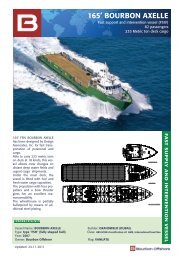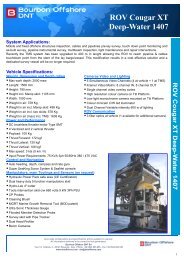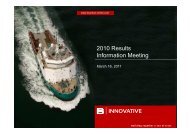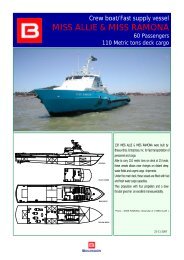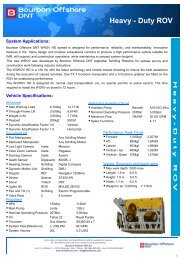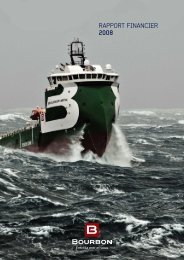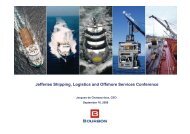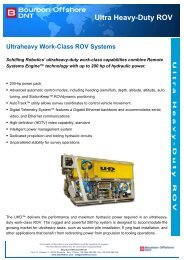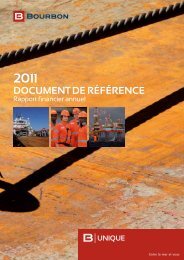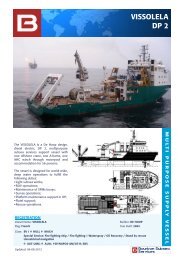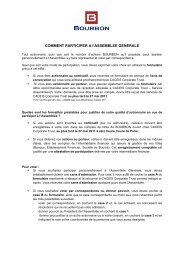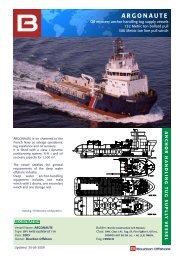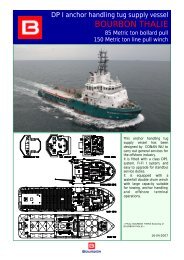REGISTRATION DOCUMENT - Bourbon
REGISTRATION DOCUMENT - Bourbon
REGISTRATION DOCUMENT - Bourbon
- No tags were found...
You also want an ePaper? Increase the reach of your titles
YUMPU automatically turns print PDFs into web optimized ePapers that Google loves.
3SocialMANAGEMENT REPORTand environmental informationAn annual HSE (health, safety and environment) plan approved byGeneral Management and disseminated throughout the Group setsthe objectives for the year. Thus performance regarding the safetyof individuals is an indicator that is constantly monitored. Accordingto a survey by the International Support Vessel Owner’s Association(ISOA), which incorporates the leading players in offshore oil and gasmarine services, BOURBON’s safety performances are among thebest in the market, as shown by LTIR and TRIR indicators:3 Lost Time Injury rate (LTIR): Frequency of accidents entailing workstoppage expressed per million hours worked (1) ;3 Total Recordable Incidents rate (TRIR): Frequency of recordableincidents which includes accidents involving stoppage of work,injuries requiring rest or a physical adjustment (employee assignedto another function, reduced hours etc.) and injuries requiringappropriate medical care and follow-up but not involving rest orstoppage of work. This frequency is also expressed per millionhours worked (1) .2.281.141.122007 20080.220.65 0.64 0.68TRIR0.07 0.052009 2010 2011In order to further motivate all the subsidiaries around the issue ofsafety at sea and onshore, BOURBON has continued its programof “Safety Awards” which rewards best HSE performance at seaand onshore as well as initiatives aimed at improving the safetyof personnel and the protection of assets and the environment inconjunction with client satisfaction.LTIR0.15.2 ENVIRONMENTAL INFORMATIONIn its concern for preservation of the environment, BOURBON plansahead of regulations and takes an innovative approach. BOURBONis committed to a program of reducing greenhouse gases, which hasalready started to bear fruit, through its systematic choice of dieselelectrictechnology which has signifi cantly lower fuel consumption.Many vessels in the fl eet are already equipped with this mode ofpropulsion, developed in conjunction with BOURBON’s selectedshipbuilding fi rms. The new series of vessels delivered under theBOURBON 2015 plan will also be equipped with this technology.The fi rst “<strong>Bourbon</strong> Evolution 800” and “PX105” type vessels to meetthe “Clean Design” standard were delivered in 2011. These vesselshave been designed and built to meet very high standards for fueltank protection, treatment of waste water and general waste.Moreover, since 2008, the Group has continued to draw up anexhaustive inventory of its fl eet’s carbon dioxide (CO 2) nitrogenoxide (NO x) and sulfur oxide (SO x) consumption and emissions.The recommendations made by international bodies in this regard,particularly the International Maritime Organization, have beenrespected.A complete software solution to meet BOURBON’s specifi crequirements is still under development and should enable the Groupto guarantee the comparability and continuity of its CO 2emissionsfi gures over future years.Furthermore, the tests conducted in 2010 on instantaneous fuelconsumption measuring systems were extended into 2011 and sothese tools should be more widely deployed from 2012 onwards.They will permit detailed data management and will provide crewsand clients with key tools for more economic operation.In the tradition of BOURBON’s commitments to sustainabledevelopment, “Responsible Surfer Crew” (Equipage SurferResponsable) competition has been launched for the 1400 and1800/18000 series Surfers operating in the Congo region. Thiscompetition has served to raise crews’ awareness of good practicesimpacting on fuel consumption with the aim of reducing greenhousegas emissions and costs.(1) Until 2010, risk exposure on-board vessels was measured on the basis of a 12-man-hour day. Since 2011, it has been be measured on the basis of a24-man-hour day, in accordance with OCIMF standards. Risk exposure on-board vessels is still measured on the basis of an eight-man-hour day;50BOURBON - 2011 Registration Document



